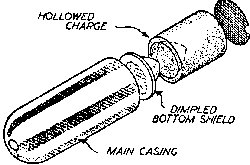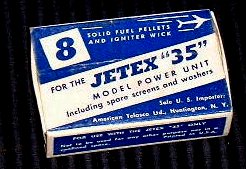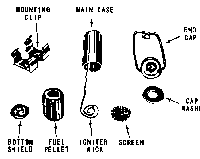|
General Description
This is the smallest
and lightest of the Jetex units, with a nominal
or rated thrust output of 3/8 to 1/2 ounce
[11-14 gm]. It has one or two different
features compared with older Jetex
units.
Apparently at least
two different 35 series motors have been sold,
of which we have little information yet. If
you can share a photo, drawing, scan, or
whatever, please let us
know so we can post them
here.
The Powermax Jet-X 35
engine can hold up to four propellant
pellets.
Historical
Notes
Also originally
designed by Wilmot and Mansour, and introduced
in the September 1953 issue of
Aeromodeller magazine (p 517). An
earlier mention of this engine is also in the
August 1953 issue, under the Gregory's
ad.
Remarks
This is the smallest
Jetex built. It is generally shaped like the
Jetex 50, being made of a pressed metal case.
Only one pellet can be loaded. The external
shape of the end cap makes it suitable for use
with an augmenter tube.
Unlike other motors,
the Atom 35 has a tapered combustion hamber
leading to the actual jet nozzle, and a cone
shaped washer in the end of the case, called a
"bottom shield." The Jetex 35 fuel pellets
have a special coned recess (some call it a
"hollowed charge") to fit this. These pellets
produce considerably reduced power for the last
2-3 seconds of burn, to assist the
power-to-glide transition. Most Jetex engines
have a surge of thrust toward the end of the
charge duration. (This is opposite the
Scorpion engine's pellet loading, where the
hollow end is inserted
last.)
Pellet charges for
the 35 may be found to be quite a tight fit in
the case, calling for adequate cleaning out
each time to avoid the fresh charge
jamming.
Suitable Model
Aircraft
Performance
Specifications
Data posted in green is from
original factory packaging and instruction sheets
Additional
Illustrations
|





